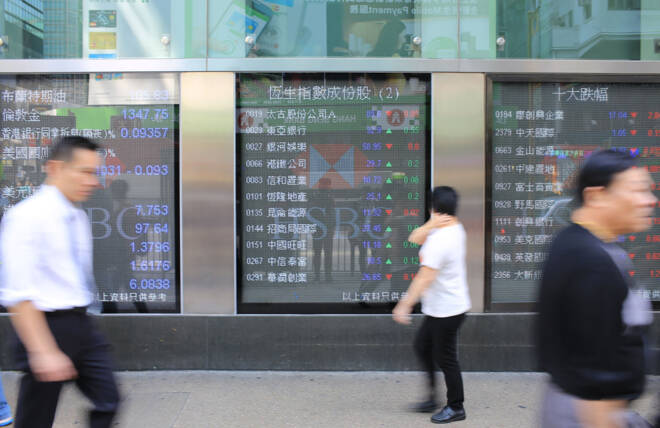Advertisement
Advertisement
Hang Seng Index Surges 1.36% on Stimulus Hopes; ASX 200 Follows US Declines
By:
Key Points:
- Hang Seng Index rallies 1.36% on Beijing stimulus hopes despite overnight US market losses.
- Japan's October household spending surged 2.9%, fueling bets on a hawkish December Bank of Japan rate hike.
- ASX 200 follows US losses, dropping 0.39% as mining stocks struggle despite a rebound in iron ore prices.
US Markets: Nasdaq Ends Four-Day Winning Streak on Profit-Taking
How did the US markets perform on Thursday, and can the US Jobs Report deliver new highs? Here’s what US equity markets revealed.
US equity markets faced losses on Thursday, December 5. The Nasdaq Composite Index fell 0.17%, ending a four-day rally. The S&P 500 and the Dow saw declines of 0.19% and 0.55%, respectively.
US stocks succumbed to profit-taking ahead of Friday’s crucial US Jobs Report. The Jobs Report could influence sentiment toward the US economy and the Fed rate path.
US Jobless Claim Trends Show Cracks in the Labor Market
US initial jobless claims increased from 215k (week ending November 23) to 224k (week ending November 30), its highest level since late October. While claims increased modestly, job cuts surged, suggesting a potential softening in the labor market. The weekly data precedes Friday’s US Jobs Report, which could give more in-depth insights into labor market conditions.
Investor caution ahead of the US Jobs Report set the tone for Friday’s Asian market session.
Japan’s Household Spending and Wages Boost BoJ Rate Hike Bets
On Friday, December 6, economic indicators from Japan supported bets on a December Bank of Japan rate hike. Household spending jumped by 2.9% month-on-month in October, reversing a 1.3% fall in September. Household spending could fuel demand-driven inflation, supporting a more hawkish BoJ rate path.
Wage growth trends also raised bets on a December BoJ rate hike. Base salaries increased by 2.7% in October, the largest increase since 1992. Additionally, overtime pay rose 1.4% year-on-year, reversing a 0.9% decline in September.
Higher wages could fuel consumer spending and demand-driven inflation, supporting a more hawkish BoJ rate path. Friday’s data drove demand for the Japanese Yen, leaving the USD/JPY down 0.19% to 149.814. A stronger Yen could reduce overseas earnings, impacting demand for export-orientated stocks, while a more hawkish BoJ rate path may weaken demand for Japanese stocks.
Hang Seng Index Climbs on Stimulus Hopes
In Asian markets, the Hang Seng Index rallied 1.36% on Friday morning, brushing aside overnight losses in the US markets.
Hopes for fresh stimulus measures from Beijing drove demand for Hong Kong-listed stocks as market focus shifted to next week’s Central Economic Work Conference. China’s President Xi Jinping and policymakers will set policies for 2025. Markets expect stimulus measures targeting domestic consumption and the real estate market to bolster the economy.
Real estate and tech stocks contributed to the morning gains. Tech giants Alibaba (9988) and Tencent (0700) advanced by 1.53% and 1.24%, respectively, sending the Hang Seng Tech Index up 1.60%. The Hang Seng Mainland Properties Index gained 1.96%.
Mainland China’s equity markets also posted morning gains. The CSI 300 and the Shanghai Composite rose 1.42% and 1.05%, respectively.
Investors hope fresh stimulus measures may counter potential US tariffs on Chinese goods. Natixis Asia Pacific Chief Economist recently commented on Trump’s tariff plans, saying,
“China was supposed to be hit with 60% additional tariffs while the rest of the world would need to put up with 10% tariffs, excluding – or so I thought -countries with free trade agreements with the US. Well, the opposite is happening. Trump has targeted Mexico and Canada with 25% import tariffs and China with only 10% additional tariffs. It seems Trump’s latest appointments will help China limit Trump’s fury while US allies will suffer more.”
On Wednesday, Trump appointed former US Senator David Perdue as the next US ambassador to the People’s Republic of China. David Perdue previously lived in Hong Kong and worked in China.
Lower-than-expected US tariffs, China stimulus measures, and improving US-China relations could drive demand for Hang Seng Index and Mainland China lists stocks.
Nikkei Drops on BoJ Rate Hike Bets and a Stronger Yen
Japan’s Nikkei Index declined by 0.90% on Friday morning. Overnight losses from the US markets, the stronger Japanese Yen, and rising BoJ rate hike bets weighed on market sentiment.
Tech stocks Softbank Group Corp. (9984) declined by 0.54%, while Tokyo Electron (8035) slid by 2.66%. Sony Corp. (6758) was down 1.80%.
ASX 200 Mirrors US Market Losses
Meanwhile, Australia’s ASX 200 Index declined by 0.39% on Friday morning. Gold, mining, and tech stocks contributed to the morning pullback. The S&P/ASX All Technology Index fell 0.94%, following the Nasdaq’s losses.
Northern Star Resources Ltd. (NST) slid by 1.54% as gold prices retreated on Thursday.
Mining giants BHP Group Ltd. (BHP) and Rio Tinto Ltd. (RIO) were down 0.22% and 0.57%, respectively.
Iron ore spot prices ended Thursday down 2.86%, impacting demand for mining stocks. However, iron ore spot prices climbed on Friday on China stimulus hopes, limiting the losses for the mining stocks. Demand from China remains crucial for iron ore prices and mining stock price trends. Stimulus measures could be a boon for BHP and Rio.
Outlook
Investors should keep an eye on developments in China’s economic policies, updates from central banks, and evolving US trade relations. Positive signals from Beijing could ease market concerns, while sentiment toward Fed, RBA, and BoJ rate paths will remain pivotal drivers.
Where do you think the Hang Seng Index is heading next? Click here for our market insights and expert analysis.
About the Author
Bob Masonauthor
With over 28 years of experience in the financial industry, Bob has worked with various global rating agencies and multinational banks. Currently he is covering currencies, commodities, alternative asset classes and global equities, focusing mostly on European and Asian markets.
Advertisement
